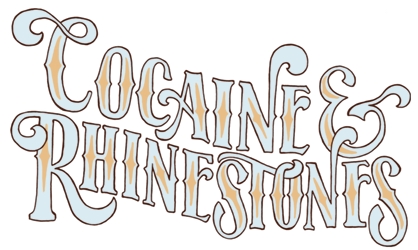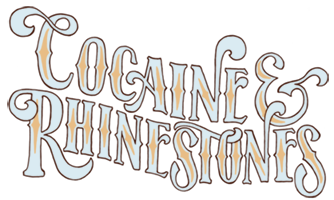
The end of one story is just the beginning of another.
Contents (Click/Tap to Scroll)
- Primary Sources – books, documentaries, etc.
- Transcript of Episode – for the readers
- Liner Notes – list of featured music, online sources, further commentary
Primary Sources
Sources for this episode can be found in The Main Library and the Season 2 Library.
Transcript of Episode
As part of my agreement with Simon & Schuster to publish a book adaptation of Season 2, the transcripts that have been freely available for over a year will be temporarily removed from this website. Please consider ordering a copy of Cocaine & Rhinestones: A History of George Jones and Tammy Wynette through your favorite local bookstore or requesting that your local library order a copy you can check out.
Liner Notes
Excerpted Music
This episode featured excerpts from the following songs, in this order [with links to purchase or stream where available]:
- Charlie Monroe & The Kentucky Pardners – “Down in the Willow Garden” [Amazon / Apple Music]
- Clarice Garland – “Billy Boy” [Amazon / Apple Music]
- Burl Ives – “Lord Randall” [Amazon / Apple Music]
- The Carter Family – “Give Me Roses While I Live” [Amazon / Apple Music]
- Leo Soileau & The Rhythm Boys – “Les Blues de la Port Arthur” [Amazon / Apple Music]
- Lydia Mendoza – “La Pollita” [Amazon / Apple Music]
- Bill Monroe & His Blue Grass Boys – “Mule Skinner Blues” (live on Grand Old Opry in 1939) [Amazon / Apple Music]
- Roy Acuff & His Crazy Tennesseans – “Great Speckle Bird, No. 2” [Amazon / Apple Music]
- Roy Acuff & His Smoky Mountain Boys – “The Precious Jewel” [Amazon / Apple Music]
- George Jones – “The Precious Jewel” [Amazon / Apple Music]
- Gene Autry – “(I’ve Got Spurs That) Jingle Jangle Jingle” [Amazon / Apple Music]
- Ernest Tubb – “You Nearly Lose Your Mind” [Amazon / Apple Music]
- Al Dexter – “Pistol Packin’ Mama” [Amazon / Apple Music]
- Hank Williams – “Last Night I Heard You Crying in Your Sleep” [Amazon / Apple Music]
- George Jones – “Last Night I Heard You Crying in Your Sleep” [Amazon / Apple Music]
- George Jones – “Cup of Loneliness” [Amazon / Apple Music]
- Hank Williams – “Lovesick Blues” [Amazon / Apple Music]
- Hank Williams – “Never Again Will I Knock on Your Door” [Amazon / Apple Music]
- Hank Williams – “Wedding Bells” [Amazon / Apple Music]
- Hank Williams – “Lost Highway” [Amazon / Apple Music]
- Lefty Frizzell – “I Love You a Thousand Ways” [Amazon / Apple Music]
- George Jones – “Sweet Imogene” [Amazon / Apple Music]
- Hank Williams – “I’ll Never Get Out of This World Alive” [Amazon / Apple Music]
Excerpted Video
These videos were excerpted in the episode. For any number of reasons, YouTube may remove them in the future but here they are for now:
Commentary and Remaining Sources
I am aware that Christopher Marlowe has been officially credited as a co-author on some new editions of Henry VI but the main scholar on the research responsible for that happening claims Shakespeare was the author of the rose garden scene.
I am aware that maybe 50% of the old folk songs I ever reference on this podcast will bear some resemblance to a song many people think of as being written by Bob Dylan. If I pointed out each instance of that happening I’d have to change the name of the entire show to Songs You Thought Were by Bob Dylan.
This wasn’t specified in the episode but “I Lost My Little Darling” was the first song Jones ever had published. Considering his first guitar was a Gene Autry acoustic, I’m sure he was thrilled when Gene Autry recorded the song in 1949.
For this intro, I did read a book called The Quest for the Rose by Roger Phillips and Martyn Nix, which you should get if you’re in the market for a picture catalog of dozens of varieties of roses or a story about the authors taking a trip to China to try to find a certain kind of rose but not if you’re looking for anything similar to this intro. However, there were a few pages at the beginning which did cover some of the facts I talked about, so I may as well mention it.
My main sources for Season 2 are all on the Library and Season 2 Library pages.
There’s been a lot of writing with outrageous and unsourced claims about what people were like in the Big Thicket and I don’t really have time to get into that but, for anyone diving into my sources for this season, I’d recommend not believing anything you read Gordon Baxter say about the Big Thicket in Dolly Carlisle’s Ragged But Right. I know Gordon’s something of a beloved character in certain circles but he was obviously talking out his ass to make sure Dolly walked away with a crazy story.
Last season, I gave all my episode-specific source books away and I am going to do that again. You don’t have to do anything special other than sign up for the mailing list. I don’t know how soon I’ll be able to get around to it but everyone on the mailing list will be entered in a random drawing and I’ll contact those who are selected to see if they want one of the books I read for Season 2. (You can ask anyone who’s been on the mailing list and they’ll tell you I only use it to send out an announcement every one or two years, so you don’t have to worry about getting a bunch of spam messages from me or anything like that.)
There will not be a Q&A episode this season because I feel like I’ve said everything I have to say. If anyone still has questions, the answers are either waiting on your next pass through Season 2 or they were never going to be here anyway. There was also a whole round of press I did around the launch of the season that many of you may have missed. Run a search for my name and you’ll find interviews in GQ, Washington Post, The Daily Beast, Noisey and a few other websites where I talk all about Season 2.
If you’re looking for another music show that is the polar opposite of this one, there’s always my other podcast with Mark Mosley, Your Favorite Band Sucks. Or if you’d like something a little nicer than that, I’d recommend checking out Andrew Hickey’s A History of Rock Music in 500 Songs.
Before I sign off, I’d like to mention the resources at SAMHSA.gov for anyone dealing with addiction or mental health issues. If you’re going through it right now, there’s no reason to go through it alone.
Alright, I’m gonna get out of here. Again, thank you for letting me tell you this story. I hope you enjoyed it.

